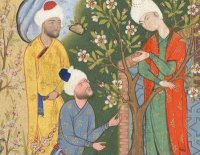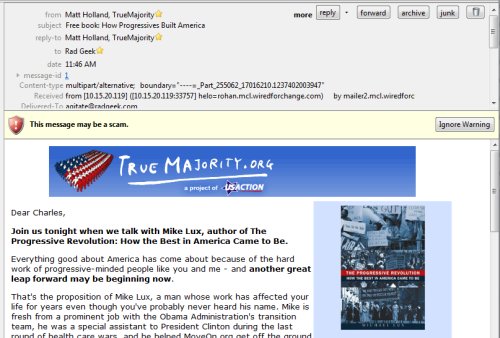Men in Uniform #2
(Via Austro-Athenian Empire 2009-03-21.)
The office at the Adiv fabric-printing shop in south Tel Aviv handles a constant stream of customers, many of them soldiers in uniform, who come to order custom clothing featuring their unit’s insignia, usually accompanied by a slogan and drawing of their choosing. Elsewhere on the premises, the sketches are turned into plates used for imprinting the ordered items, mainly T-shirts and baseball caps, but also hoodies, fleece jackets and pants. A young Arab man from Jaffa supervises the workers who imprint the words and pictures, and afterward hands over the finished product.
Dead babies, mothers weeping on their children’s graves, a gun aimed at a child and bombed-out mosques — these are a few examples of the images Israel Defense Forces soldiers design these days to print on shirts they order to mark the end of training, or of field duty. The slogans accompanying the drawings are not exactly anemic either: A T-shirt for infantry snipers bears the inscription
Better use Durex,next to a picture of a dead Palestinian baby, with his weeping mother and a teddy bear beside him. A sharpshooter’s T-shirt from the Givati Brigade’s Shaked battalion shows a pregnant Palestinian woman with a bull’s-eye superimposed on her belly, with the slogan, in English,1 shot, 2 kills.Agraduationshirt for those who have completed another snipers course depicts a Palestinian baby, who grows into a combative boy and then an armed adult, with the inscription,No matter how it begins, we’ll put an end to it.. . . A few of the images underscore actions whose existence the army officially denies – such as
confirming the kill(shooting a bullet into an enemy victim’s head from close range, to ensure he is dead), or harming religious sites, or female or child non-combatants. In many cases, the content is submitted for approval to one of the unit’s commanders. The latter, however, do not always have control over what gets printed, because the artwork is a private initiative of soldiers that they never hear about. Drawings or slogans previously banned in certain units have been approved for distribution elsewhere. For example, shirts declaring,We won’t chill 'til we confirm the killwere banned in the past (the IDF claims that the practice doesn’t exist), yet the Haruv battalion printed some last year.The slogan
Let every Arab mother know that her son’s fate is in my hands!had previously been banned for use on another infantry unit’s shirt. A Givati soldier said this week, however, that at the end of last year, his platoon printed up dozens of shirts, fleece jackets and pants bearing this slogan.
It has a drawing depicting a soldier as the Angel of Death, next to a gun and an Arab town,he explains.The text was very powerful. The funniest part was that when our soldier came to get the shirts, the man who printed them was an Arab, and the soldier felt so bad that he told the girl at the counter to bring them to him.— Uri Blau, Ha'aretz (2009-03-20): Dead Palestinian babies and bombed mosques – IDF fashion 2009
One of the most consistent themes running through the designs for these t-shirts is the use of sexualized violence — in particular, cartoons of rape and verbal threats of rape against women and men identified with the enemy
— as the punchline and the basis for bonding
among the men in uniform.
There are also plenty of shirts with blatant sexual messages [sic –R.G.]. For example, the Lavi battalion produced a shirt featuring a drawing of a soldier next to a young woman with bruises, and the slogan,
Bet you got raped!. . . After Operation Cast Lead [the Israeli government’s invasion of Gaza from December 2008 – January 2009], soldiers from that battalion printed a T-shirt depicting a vulture sexually penetrating Hamas’ prime minister, Ismail Haniyeh, accompanied by a particularly graphic slogan. S., a soldier in the platoon that ordered the shirt, said the idea came from a similar shirt, printed after the Second Lebanon War, that featured Hassan Nasrallah instead of Haniyeh. . . .
[Ha'aretz:] What’s the problem with this shirt?
S.:
It bothers some people to see these things, from a religious standpoint …. . .
[IDF veteran Yossi] Kaufman has also been exposed to T-shirts of the sort described here.
I know there are shirts like these,he says.I’ve heard and also seen a little. These are not shirts that soldiers can wear in civilian life, because they would get stoned, nor at a battalion get-together, because the battalion commander would be pissed off. They wear them on very rare occasions. There’s all sorts of black humor stuff, mainly from snipers . . . . There’s a Golani or Givati shirt of a soldier raping a girl, and underneath it says,No virgins, no terror attacks.I laughed, but it was pretty awful. When I was asked once to draw things like that, I said it wasn’t appropriate.. . .
Sociologist Dr. Orna Sasson-Levy, of Bar-Ilan University, author of Identities in Uniform: Masculinities and Femininities in the Israeli Military, said that the phenomenon is
part of a radicalization process the entire country is undergoing, and the soldiers are at its forefront. I think that ever since the second intifada there has been a continual shift to the right. The pullout from Gaza and its outcome — the calm that never arrived — led to a further shift rightward.
This tendency is most strikingly evident among soldiers who encounter various situations in the territories on a daily basis. There is less meticulousness than in the past, and increasing callousness. There is a perception that the Palestinian is not a person, a human being entitled to basic rights, and therefore anything may be done to him. [sic –R.G.]Could the printing of clothing be viewed also as a means of venting aggression?
Sasson-Levy:
No. I think it strengthens and stimulates aggression and legitimizes it. What disturbs me is that a shirt is something that has permanence. The soldiers later wear it in civilian life; their girlfriends wear it afterward. It is not a statement, but rather something physical that remains, that is out there in the world. Beyond that, I think the link made between sexist views and nationalist views, as in theScrew Haniyehshirt, is interesting. National chauvinism and gender chauvinism combine and strengthen one another. It establishes a masculinity shaped by violent aggression toward women and Arabs; a masculinity that considers it legitimate to speak in a crude and violent manner toward women and Arabs.Col. (res.) Ron Levy began his military service in the Sayeret Matkal elite commando force before the Six-Day War. He was the IDF’s chief psychologist, and headed the army’s mental health department in the 1980s.
Levy:
I’m familiar with things of this sort going back 40, 50 years, and each time they take a different form. Psychologically speaking, this is one of the ways in which soldiers project their anger, frustration and violence. It is a certain expression of things, which I callbelow the belt.[sic –R.G.]— Uri Blau, Ha'aretz (2009-03-20): Dead Palestinian babies and bombed mosques – IDF fashion 2009


